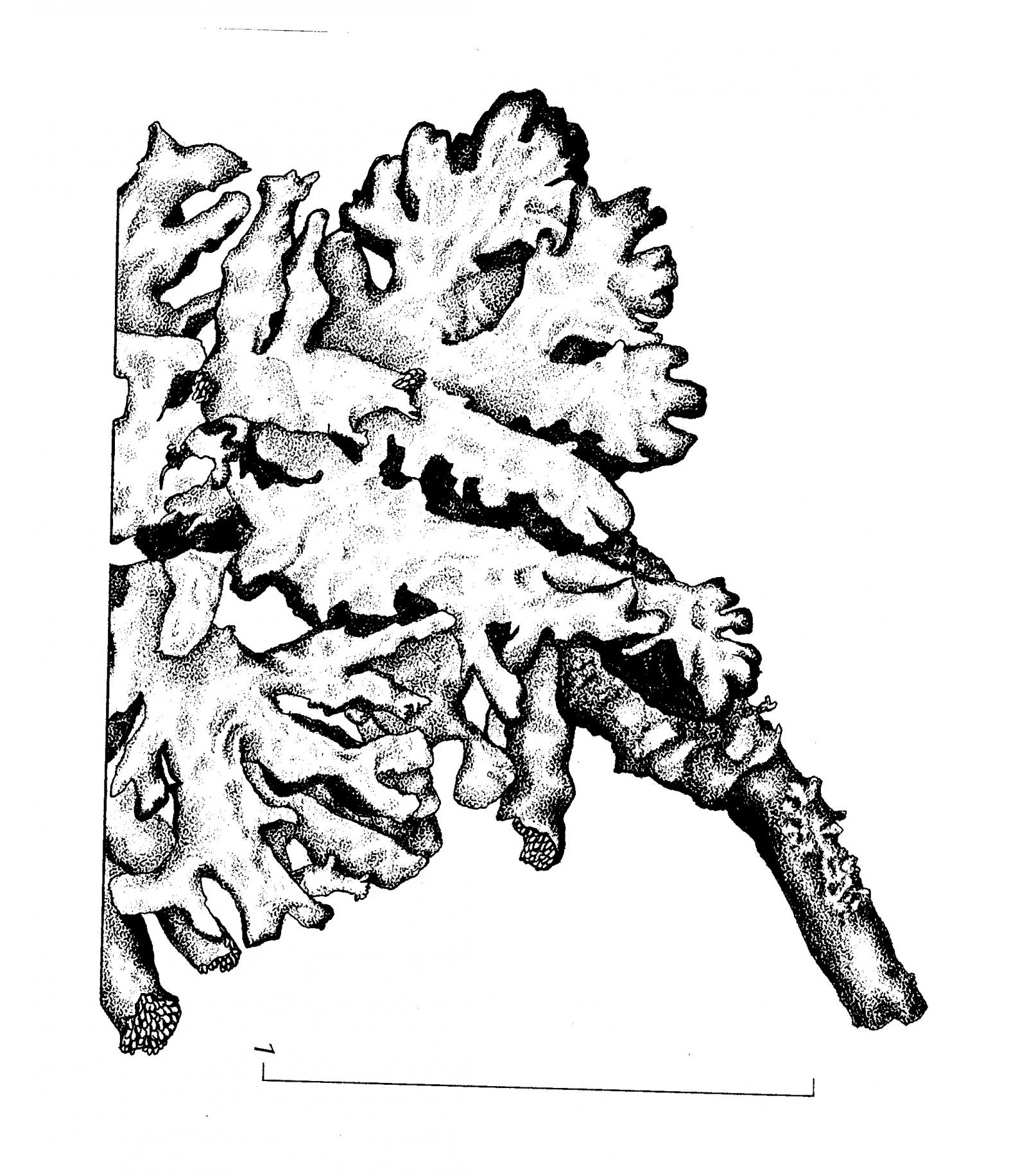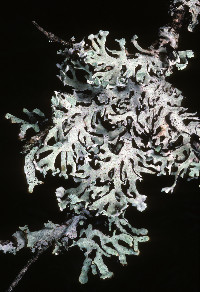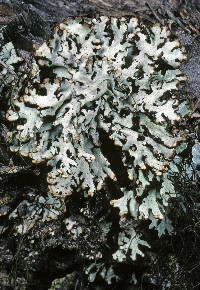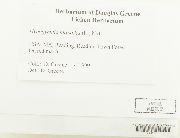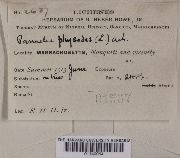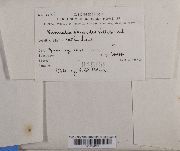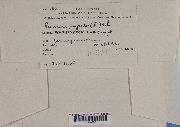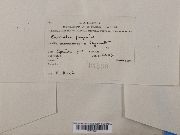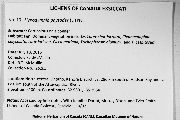
Consortium of Lichen Herbaria
- building a Global Consortium of Bryophytes and Lichens as keystones of cryptobiotic communities -
- Home
- Search
- Images
- Species Checklists
- US States: O-Z >
- US National Parks
- Central America
- South America
- US National Parks
- Southern Subpolar Region
|
|
|
|
Family: Parmeliaceae
[Ceratophyllum physodes (L.) M. Choisy, moreCeratophyllum physodes var. fulvescens (Harm.) M. Choisy, Ceratophyllum physodes var. labrosa (Ach.) M. Choisy, Ceratophyllum physodes var. luxurians (Harm.) M. Choisy, Ceratophyllum physodes var. physodes (L.) M. Choisy, Ceratophyllum physodes var. platyphylla (Ach.) M. Choisy, Hypogymnia physodes f. labrosa (Ach.) Walt. Watson, Hypogymnia physodes f. platyphylla (Ach.) Rass., Hypogymnia physodes f. subtubulosa (Anders) Rass., Hypogymnia physodes f. vittatoides (Mereschk.) Räsänen, Hypogymnia physodes var. labrosa (Ach.) Parrique, Hypogymnia physodes var. platyphylla (Ach.) Walt. Watson, Imbricaria physodes (L.) DC., Imbricaria physodes f. physodes (L.) DC., Imbricaria physodes f. subcrustacea Flot., Lichen physodes L., Lobaria physodes (L.) Hoffm., Menegazzia physodes (L.) Navás, Parmelia ceratophylla var. physodes (L.) Schaer., Parmelia duplicata var. douglasicola Gyeln., Parmelia oregana Gyeln., Parmelia physodes Ach., Parmelia physodes f. cassidiformis Vereit., Parmelia physodes f. corallina Erichsen, Parmelia physodes f. deserti Hue, Parmelia physodes f. elegans Mereschk., Parmelia physodes f. epiphylla Savicz, Parmelia physodes f. euphysodes Maas Geest., Parmelia physodes f. foraminifera Wereit.{?}, Parmelia physodes f. formicata Gyeln., Parmelia physodes f. fuscescens Cromb. ex Gyeln., Parmelia physodes f. granulosa Harm., Parmelia physodes f. isidiosa Anders, Parmelia physodes f. lugubris (Pers.) F. Wilson, Parmelia physodes f. luxurians Harm., Parmelia physodes f. maculans H. Olivier, Parmelia physodes f. minor Hilitzer, Parmelia physodes f. neosorediosa Gyeln., Parmelia physodes f. papillosa Erichsen, Parmelia physodes f. physodes (L.) Ach., Parmelia physodes f. pinicola Gyeln., Parmelia physodes f. pseudofarinacea Anders, Parmelia physodes f. rugosa G. Merr., Parmelia physodes f. stigmatea Bitter, Parmelia physodes f. subcrustacea Flot., Parmelia physodes f. sublugubris Räsänen, Parmelia physodes f. subtubulosa Anders, Parmelia physodes f. vittatoides Mereschk., Parmelia physodes var. compacta Müll.Arg., Parmelia physodes var. fulvescens Harm., Parmelia physodes var. glaucoides Gyeln., Parmelia physodes var. labrosa Ach., Parmelia physodes var. leucina Müll.Arg., Parmelia physodes var. lugubris (Pers.) Nyl., Parmelia physodes var. mesotropa Müll.Arg., Parmelia physodes var. mundata (Nyl.) Müll.Arg., Parmelia physodes var. physodes (L.) Ach., Parmelia physodes var. pinnata Anders, Parmelia physodes var. placorhodioides (Nyl.) Müll.Arg., Parmelia physodes var. platyphylla Ach., Parmelia physodes var. prolificans Erichsen, Parmelia physodes var. pseudofarinacea (Anders) Erichsen, Parmelia physodes var. rugosa Müll.Arg., Parmelia physodes var. sublugubris Müll.Arg., Parmelia physodes var. tenuis Müll.Arg., Parmelia platyphylla (Ach.) Röhl., Parmelia vitatta , Physcia physodes (L.) Frege] |
Nash, T.H., Ryan, B.D., Gries, C., Bungartz, F., (eds.) 2002. Lichen Flora of the Greater Sonoran Desert Region. Vol 1. Thallus: appressed, up to 6 (-8) cm broad; texture: cartilaginous; branching: isotomic dichotomous, budding occasional lobes: contiguous to imbricate or ± separate, 0.5-2.5 (-4) mm broad; black border: not visible from above; profile: even to irregular; width/height ratio: 1-4; tips and axils: entire or torn upper surface: white, gray to greenish gray, dark mottles none or rare, occasionally rugose soredia: on the inside of the burst lobe tips, appearing as if in labriform soralia; isidia absent, lobules rare medulla: hollow, ceiling of cavity white or dark, floor of cavity dark lower surface: black, rarely perforate Apothecia: rare, substipitate to stipitate, up to 2 (-4) mm in diam; stipe: funnel-shaped, hollow; disc: brown ascospores: ellipsoid, 7-8 x 4.5-5.5 µm Pycnidia: occasional conidia: rod shaped, 5.5-5.8 x 0.5-0.6 µm Spot tests: cortex K+ yellow, C-, KC-, P+ pale yellow, UV-; medulla K-, C-, KC+ orange-red, P+ orange-red. Secondary metabolites: upper cortex with atranorin and chloroatranorin; medulla with physodic acid (major), 2'-O-methylphysodic acid (minor or accessory), 3-hydroxyphysodic acid (major), physodalic acid (major), and protocetraric acid (minor). Substrate and ecology: on bark or wood including conifers and hardwoods, rarely on rock, moss, or alpine sod World distribution: circumpolar arctic, boreal, and montane; northern Asia, North America, and Europe; throughout northern North America, south in California to about Santa Cruz and S throughout the Appalachian and Rocky Mountains Sonoran distribution: southern Rocky Mountains. Notes: Although this generalist species is widespread and common in the northern hemisphere, in the southwestern U.S. and Mexico it is apparently restricted to the higher mountains in a continental climate. It is remarkably consistent in chemistry considering its wide geographic range and the variability in chemistry of so many Hypogymnia species. Occasional small esorediate individuals can be recognized by the P+ medulla and imperforate lobe tips. |
|
|
|
Powered by Symbiota

